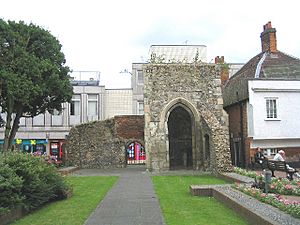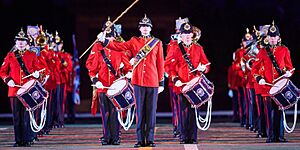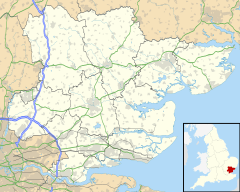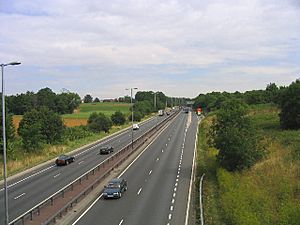Brentwood, Essex facts for kids
Quick facts for kids Brentwood |
|
|---|---|
 The ruins of the Chapel of Thomas Becket |
|
| Population | 55,340 (built-up area, 2021) |
| OS grid reference | TQ595938 |
| District |
|
| Shire county | |
| Region | |
| Country | England |
| Sovereign state | United Kingdom |
| Post town | Brentwood |
| Postcode district | CM13-CM15 |
| Dialling code | 01277 |
| Police | Essex |
| Fire | Essex |
| Ambulance | East of England |
| EU Parliament | East of England |
| UK Parliament |
|
Brentwood is a lively town in Essex, England. It's about 20 miles (30 km) north-east of Charing Cross in London, making it part of the London commuter belt. In 2021, about 55,340 people lived here.
Brentwood has a busy shopping area along its High Street. This street used to be an old Roman road, which was a main route between London and East Anglia. Around the town centre, you'll find homes surrounded by green fields and forests. Some of this beautiful countryside is very close to the town. Brentwood is also home to Brentwood Cathedral, which is an important church for the Roman Catholic Diocese of Brentwood.
Since 1978, Brentwood has been twinned with Roth in Germany. It also became twinned with Montbazon in France in 1994. The town also has a special friendship with Brentwood, Tennessee in the United States.
Contents
Discover Brentwood's Past
A Look Back in Time
What's in a Name?
The name "Brentwood" likely comes from the words "burnt" and "wood." In Middle English, "brent" meant "burnt." This name probably describes how the town started: as a clearing made by fire in the Great Forest that once covered the area. People here often made charcoal by burning wood.
Another idea is that "brent" could mean "holy one." This might refer to the chapel built for Thomas Becket. Pilgrims traveling to Canterbury would stop there.
Early Settlements
Even though a Bronze Age axe was found in Brentwood, and there are signs of an old camp in Weald Country Park, it's thought that not many people lived here very early on. Most of Essex was covered by a huge forest back then. Even with a Roman road passing through, historians believe the Saxons were the first real settlers in the area.
Some stories say that Brentwood was the site of a big battle in 44 AD. This is where Claudius supposedly defeated the Ancient Britons. However, these stories might not be entirely true.

Brentwood began as a small space cleared in a thick forest, likely by fire. This gave it the name "Burntwood," or "the place where the wood was burned." People started to live there. Because it was on the main Roman road from Colchester to London, and a route for pilgrims going to Canterbury, it grew into a small town.
A chapel was built around 1221. In 1227, the town was given permission to hold a market. This new town was on high ground, where the main London-Colchester road met the Ongar-Tilbury road. Its growth was helped by the popularity of St. Thomas the Martyr, to whom the chapel was dedicated. The 12th-century ruins of the Thomas Becket Chapel are still in the town centre. They were a popular stop for pilgrims. The nearby parish church of Brentwood is also dedicated to St. Thomas of Canterbury. A place called Pilgrims Hatch was probably named after pilgrims who passed through on their way to the chapel.
Brentwood's growth was mainly due to its location on a major road, its market, and its use as an administrative centre. Early jobs included making textiles and clothes, brewing, and making bricks.
The Peasants' Revolt Connection
In 1381, during the Peasants' Revolt, Brentwood was a meeting spot for some of the leaders, like John Ball and Jack Straw. The first event of the revolt happened in Brentwood. Officials tried to make people pay a tax they felt was unfair. When the people refused, a riot started. The rioters then spread the word, starting the larger Peasants' Revolt across the country.
One of Brentwood's oldest buildings is The White Hart. It was built around 1480. It's believed that King Richard II visited it in 1392. The ground floor was originally for horses. In the 1700s, its owners even ran their own coach service to London.
Marygreen Manor, a beautiful 16th-century building, is mentioned in Samuel Pepys' famous diaries. It's said that Henry VIII often visited it. Today, it is a hotel and restaurant. In 1686, Brentwood's inns had 110 beds and space for 183 horses. By 1788, there were 11 inns in the town.
A young man named William Hunter was killed in Brentwood in 1555 for his Protestant beliefs. A monument was built for him in 1861. Brentwood School was founded in 1557 by Sir Anthony Browne. A plaque at the school marks the spot where Hunter was killed.
As the Roman road became busier, Brentwood became a major stop for stagecoaches. There were many inns for travelers to stay overnight while horses rested. Brentwood was about 20 miles (30 km) from London, making it a good second stop for those traveling to East Anglia. The town still has many pubs, possibly because the army was based at Warley Barracks until 1958. Some pubs date back to the 15th and 16th centuries. Brentwood was also important for the London postal service, with a major post office since the 18th century.
The writer Daniel Defoe described Brentwood as being "...full of good inns, and chiefly maintained by the excessive multitude of carriers and passengers, which are constantly passing this way to London, with droves of cattle, provisions and manufactures."
The "Brentwood Ring," the oldest Christian ring ever found in Britain, was discovered here in the late 1940s. It is now at the British Museum in London. The only other ring like it is at the Vatican Museum in Rome.
Modern Brentwood's Growth
Brentwood started as a small parish of about 460 acres (1.86 km²). In 1891, it had 4,949 people. Over time, its local government changed and grew. In 1934, it became much larger, taking in nearby areas. In 1974, it grew again to cover about 36,378 acres. In 1993, Brentwood officially became a borough.
In 1917, the Roman Catholic church on Ingrave Road became a cathedral. Between 1989 and 1991, it was rebuilt in an Italian style. Brentwood Cathedral is now the main church for the Roman Catholic Bishop of Brentwood.
Ingatestone Hall is a 16th-century manor house near Brentwood. It was built by Sir William Petre, a very important person who worked for four Tudor monarchs: Henry VIII, Edward VI, Mary I, and Elizabeth I. Queen Mary and Queen Elizabeth I both stayed at Ingatestone Hall.
Today, Ingatestone Hall shows off the wealth and status of its original owners. It still has many features of a 16th-century knight's home. The house has been used in TV shows, like the 2005 adaptation of Charles Dickens' Bleak House. You can visit Ingatestone Hall for tours, concerts, and other events.
Brentwood was also home to Warley Hospital, a hospital for mental health, from 1853 to 2001. A British East India Company school for training elephants was once here! Later, it became an army base for the Essex Regiment until 1959. Much of this site was then used to build the European headquarters for the Ford Motor Company. Some old army buildings still remain, like the chapel and the officers' mess.
Brentwood's Military Story
The area of Warley has had military connections for over 200 years. It was important during the time of the Spanish Armada, serving as a meeting place for soldiers from eight counties. The local common was used as a military camp in 1742 and became a permanent base, Warley Barracks, in 1804.
During World War II, over 1,000 bombs were dropped on Brentwood. This included flying bombs (V1) and rockets (V2). Many houses were destroyed, and people were injured or died. However, the old 15th and 16th-century pubs survived. Brentwood was considered safe enough for children to be moved there from London. About 6,000 children arrived in September 1939 alone.
Brentwood Today
Brentwood is becoming more like a suburb, but it still feels very rural. You can find trees, fields, and open spaces all around the town. Shenfield Common is less than a mile from the town centre shops.
Brentwood's High Street has had big improvements, costing millions of pounds. This included adding a new lane to help traffic flow and re-doing the pavements and road.
Learning in Brentwood
Brentwood has many schools for different age groups.
- Secondary schools include Brentwood County High School, Brentwood School, St Martin's School, and Becket Keys Church of England School.
- Primary schools include St Helens Catholic Junior School, St Peters C of E, St Thomas of Canterbury C of E, Warley Primary, Willowbrook Primary, Holly Trees Primary, Hogarth Primary, and Larchwood Primary School.
Businesses in Brentwood
Brentwood has been home to several important businesses.
The Ford Motor Company's UK headquarters were in Warley until 2018.
In the financial world, Equity Insurance Group has its main office in the town centre. The Bank of New York Mellon and LV= also have large offices here, with LV= employing 350 people.
The electronics company Amstrad used to have its headquarters in Brentwood. The TV show The Apprentice used to show views of London's Canary Wharf, but the inside shots were actually from Amstrad's old offices in Brentwood. These offices are now a hotel.
Other well-known companies that used to operate in Brentwood include Thermos, which made vacuum flasks, and Nissen, which made trampolines.
How Brentwood is Governed
Brentwood has two levels of local government. The Brentwood Borough Council is based at Brentwood Town Hall. The larger Essex County Council is based in Chelmsford.
Brentwood started as a small part of the South Weald parish. It became its own civil parish in 1866. Over the years, its boundaries changed and grew. In 1974, the larger Brentwood District was created, and in 1993, it officially became a borough.
For national elections, Brentwood is part of the Brentwood and Ongar constituency.
Arts and Entertainment
Brentwood has a lively arts scene. The Brentwood Theatre and The Hermitage are key cultural buildings in the town centre.
The Brentwood Theatre is a community theatre used by over 40 local performing arts groups. It's run by a charity and doesn't receive regular government funding. The Hermitage is a centre for youth services.
The Hermitage youth service has its own cafe, youth club, and a music venue called The Hermit. This venue has hosted famous bands like Motörhead and InMe. It helps new youth bands get started. It also hosts a weekly jazz club and the Brentwood Blues Festival, which has featured artists like the Blockheads and Bill Wyman.
Local TV news is provided by BBC London and ITV London. Some areas can also get BBC East and ITV Anglia.
Local radio stations include BBC Essex on 95.3 FM, Heart Essex on 96.3 FM, and Phoenix FM. Phoenix FM is a community radio station that started broadcasting permanently in 2007 on 98.0 FM. It plays popular music, features local musicians, covers local events, and interviews local figures.
The Brentwood Art Trail is a popular yearly summer event. It lets local artists show their work to the community.

Brentwood is also home to the Brentwood Imperial Youth Band. This successful band performs at many events throughout the year and includes young people from age 10. It was the first British band to take part in the Tournament of Roses Parade in Pasadena, California. It was also the first youth band to play at the Spasskaya Tower Military Music Festival and Tattoo in Moscow's Red Square. The band practices twice a week in Warley.
Many theatre groups are in the area, like Brentwood Operatic Society and Shenfield Operatic Society. They put on great shows for the community. Brentwood Operatic Society also trains young actors through its BOSSY Youth program.
Brentwood's Orchestras for Young People started in 1990. It now has five groups for school-aged musicians. They perform regularly and learn many different types of music, from classical to modern.
The Brentwood Performing Arts Festival is now part of the British and International Federation of Festivals. This means it's recognized as the official Performing Arts Festival for Brentwood.
The town also hosts the Brentwood International Chess Congress. This event started in 2006 and attracts many chess players, including Grandmasters. It's the largest chess competition in Essex.
Sports, Parks, and Green Spaces
Even though Brentwood is close to London, it's surrounded by open countryside and forests. This shows how well the Metropolitan Green Belt has stopped London's buildings from spreading too far.
Brentwood has many public green spaces. These include King George V Playing Field, Shenfield Common, and two country parks at South Weald and Thorndon. Weald Country Park was first chosen for the 2012 Olympics mountain biking, but the course was thought to be "too easy." However, Brentwood does host Criterium Cycle Races, which attract many top British cyclists.
The town has two large sports centres where you can play badminton, squash, swim, and play football. There are also several golf courses, including a public course near the town centre at Hartswood. Many cricket clubs are in the area. Brentwood is home to the non-league football club Brentwood Town F.C. and the basketball team London Leopards. Both play at the Brentwood Centre Arena. Brentwood RLFC is the only rugby league club in west Essex. Brentwood Hockey Club is also based here.
Brentwood Running Club (started in 1987) helps local runners get fit and meet others. They meet on Wednesdays at the Brentwood Centre. They also have a "Couch to 5k" program twice a year for beginners.
In 2022, a new track and field club, Brentwood Beagles Athletics Club, started at Brentwood School. It has over 250 members, from age five to adults. They compete in track and field, road running, and cross country. In their first year, they won several awards and had athletes competing nationally.
Brentwood was a key place for trampolining in the UK from 1965 to 1981. George Nissen brought the sport here in 1949 and later made trampolines in the town. Ted Blake, a long-time Brentwood resident, was a world leader in developing modern trampolining. Brentwood still has a strong trampolining community.
The town also has a large volleyball club and the only handball club in Essex.
Famous People from Brentwood
Many well-known people have connections to Brentwood:
- Trevor Brooking — former footballer
- Frank Bruno — boxer
- Leddra Chapman — singer
- Steve Davis — snooker player
- Flynn Downes — footballer
- Jonathan Firth — actor
- Barry Hearn — sports investor
- Eddie Hearn — sports promoter
- Jonty Hearnden — television presenter
- Johnny Herbert — Formula One race winner
- John Jervis — admiral
- Matthew Jorysz — organist
- Sarah Kane — playwright
- Ross Kemp — actor
- Sonja Kristina — singer
- Carlton Leach — former criminal
- Pixie Lott — singer
- Jodie Marsh — glamour model
- Perry McCarthy — Formula One driver
- Dave McPherson — musician
- William Merrifield — Canadian soldier
- Billy Murray — actor
- Noel Moore — civil servant
- Stephen Moyer — actor
- Jesy Nelson — former member of Little Mix
- Ray Parlour — former footballer
- Eric Pickles — politician
- Louise Redknapp — model and singer
- Neil Ruddock — former footballer
- Jeff Randall — journalist
- Logan Sama — grime DJ
- Thomas Skinner — businessman
- Ellie Taylor — comedian
- Rhys Thomas — actor and director
- Fatima Whitbread — Olympic medallist
- Paul Wickens — musician
- Danny Young — actor
Some famous people who went to Brentwood School include:
- Douglas Adams - writer
- Robin Day - political broadcaster
- Noel Edmonds - television presenter
- Frank Lampard - footballer
- Eddie Hearn - sports promoter
- Griff Rhys Jones - actor
- Jack Straw - politician
Getting Around Brentwood
Buses
Brentwood has many bus services, mainly run by First Essex. Other companies like Arriva Herts & Essex, Ensignbus, and Stagecoach London also provide services. London Buses route 498 connects Romford with Brentwood every day.
Roads
The A12 road, which goes between London and Lowestoft, passes north of the town. The M25 motorway, which circles London, is about 1.2 miles (2 km) south-west of Brentwood. The A128 goes through the town centre, linking Ongar with Orsett. The A129 passes through the north and east, connecting Brentwood with Billericay and Hadleigh. The A1023 also goes through Brentwood, linking it to the A12.
Trains
Brentwood railway station is south of the town centre. It has frequent Elizabeth line trains that go between Shenfield and London Paddington, passing through Liverpool Street. Two trains per hour continue to Heathrow Terminal 5.
Other stations in the Borough of Brentwood include Ingatestone and Shenfield. These offer fast services to Liverpool Street and East Anglia. West Horndon has trains between London Fenchurch Street and Shoeburyness.
The closest London Underground stations are just outside the borough. These are Newbury Park (on the Central line) and Upminster (on the District line).
See also
 In Spanish: Brentwood (Reino Unido) para niños
In Spanish: Brentwood (Reino Unido) para niños







